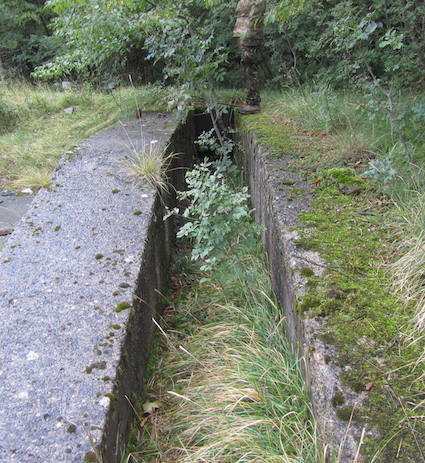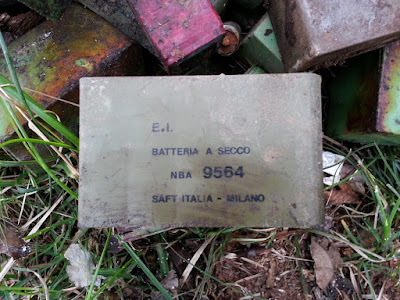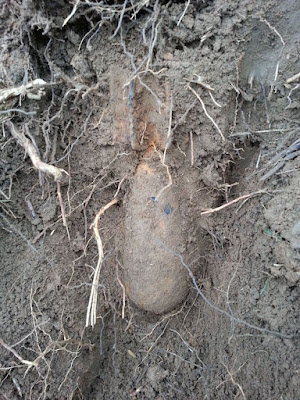AN ENVIRONMENT AND ITS LEGACY OF POLLUTION

Waste oil drain in a former Italian Army military barrack on the Trieste Karst. The draining ends in an underlying cave.
When dealing with the serious problem of pollution in the Free Territory of Trieste it is important distinguishing between ordinary, urban waste and the pollution caused by the many military actions that took place there.
Both forms of pollution affect this small State, one that its own adminsitering authorities abandoned, as soon as they allowed it to be systematically polluted, “scorch the ground” because its only purpose was serving against the Warsaw Pact.
Be it civilians led by soldiers, be it the other way around: the goal was the same. Each and every inch of the Trieste area could, and had to be sacrificed. Including the international Free Port. Even if the enemy got hold of this land, it would be a land of ruins and pollution.
Obviously, the legacy of this “undeclared war” is only heavier considering how small the area it affected is: the present-day Free Territory of Trieste.
Be it civil or military landfills, they are usually indistinguishable: the Free Territory’s about 212 km² are heavily contaminated. From the coastline, to the deeps of the Gulf, the Karst plateau (including its hypogeal system), and the valleys of streams Rosandra and Ospo.
But there is more: on top of this polluted land there are now houses, industrial plants, shopping malls, even touristic and seaside resorts. And we know only a small, way too small part of the story yet. Because traveling back in time means means digging deep into meters and meters of pollution and facing a State crime and its story.
The Italian Army has left a lot of pollution in Trieste. And the many, dismissed military areas that have been abandoned to complete degradation are finally revealing all about it. Underground fuel depots, training areas, old barracks: you name it. They are all contaminated. When the military left, nobody bothered to reclaim the contaminated land that was left behind.

Accumulation of expired Italian Army batteries in front of a cave entrance within a a military zone on the Trieste Karst.
Today, the past returns from many natural or artificial cavities, the Karst has many, and they contain evidences, they testify the sacrifice of this land, raped by those who should have guarded it instead. Unexploded bombs, expired batteries, drums full of poisons that by now have leaked in the bowels of the earth.
A lot of contaminative material was pour into the caves. In Italian barracks, they considered it normal using caves as dumping grounds for open-field workshops. Waste oil from military vehicles would flow in the caves. Oil from all military vehicles, including armored combat vehicles. A river of oils, hydrocarbons, thinners, varnishes: it all flew in the deeps of the Karst, contaminating its aquifers.
Other caves are filled with hundreds and hundreds of expired batteries. Who knows how many other poisons hide in the abysses of Trieste’s Karst. This is the legacy of a polluted environment.
Translated from blog “Environment and Legality” by Roberto Giurastante

Mortar bomb buried in a former Italian Army training area on the Trieste Karst.

RT @TriesteLibera: THE ENVIRONMENTAL LEGACY OF A MILITARY OCCUPATION #environment #Trieste https://t.co/qDGJzIqqRU
THE ENVIRONMENTAL LEGACY OF A MILITARY OCCUPATION #environment #Trieste @RobertoGiurasta @TLambiente @TriesteLibera https://t.co/8DkQAhTEcH
RT @TriesteLibera: THE ENVIRONMENTAL LEGACY OF A MILITARY OCCUPATION #environment #Trieste https://t.co/qDGJzIqqRU
RT @TriesteLibera: @RobertoGiurasta THE ENVIRONMENTAL LEGACY OF A MILITARY OCCUPATION #environment #Trieste https://t.co/qDGJzIqqRU
THE ENVIRONMENTAL LEGACY OF A MILITARY OCCUPATION by @RobertoGiurasta @TLambiente @TriesteLibera https://t.co/8DkQAhTEcH
THE ENVIRONMENTAL LEGACY OF A MILITARY OCCUPATION #environment #Trieste https://t.co/qDGJzIqqRU
@RobertoGiurasta THE ENVIRONMENTAL LEGACY OF A MILITARY OCCUPATION #environment #Trieste https://t.co/qDGJzIqqRU